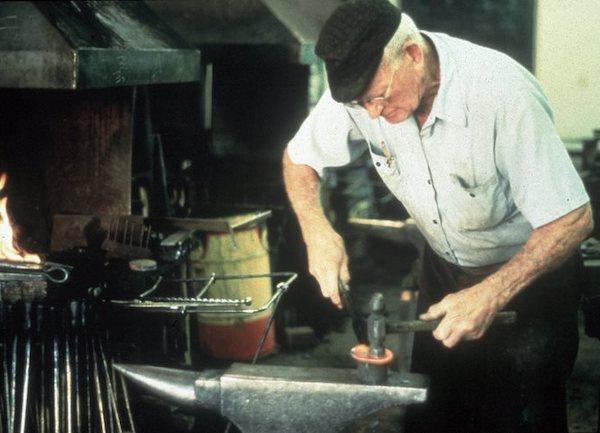Francis Whitaker

Photograph by Alan Govenar
Bio
Francis Whitaker was born November 29, 1906, in Woburn, Massachusetts. He left high school at the age of 16 to apprentice with the premier ornamental blacksmith of the day, Samuel Yellin, in Philadelphia. "The first time I took a piece of hot iron out of the fire and started to beat it with a hammer, I was hooked," he said.
But learning to become a master blacksmith, Whitaker found, was hard work and meant starting at the bottom at Yellin's shop, for he had 200 men laboring at his forge. "I had to clean out the forges in the morning," Whitaker said. "I was told to get there early, a half an hour early. I wasn't paid for it. A little bit later on, I also had the job of starting the fires so that the fire was ready when the smith came to work at 8:00."
After a year with Yellin, Whitaker volunteered for a three-year apprenticeship in Berlin with the German master Julius Schramm. He recalled, "I got to be the blacksmith's helper for the top smith. There were only two smiths there, but the top smith, that was the coveted job, and I worked like hell to hold that position."
In 1927, he returned to the United States and settled in Carmel, California, where work was plentiful. "Those were very productive years. California was building up with the Spanish tradition. There was a great deal of ironwork: door hardware, railings, gates, curtain rods. Houses were filled with ironwork then. This was in an area where there was a good deal of money and a lot of good taste in design."
Whitaker spent seven years as the head smith for a large contracting firm with major commissions in the Pebble Beach and Carmel area. He then secured a job with another contractor who had his own blacksmith shop with two forges, two smiths, and a couple of helpers. In 1933, Whitaker opened his own forge, The Forge in the Forest, and despite the depths of the Great Depression he managed to build his own business. "The Depression," he said, "taught me that if you're dedicated to your work and do good work and are uncompromising about it, there will always be a place for you in society. The others can fall by the wayside, the second-raters."
In addition to ornamental ironwork, Whitaker sharpened tools, welded fenders, built truck bodies and stair railings, and made fireplace tools and andirons. He maintained high standards for his work, and his reputation grew. During World War II, he did production work and was the head instructor in welding at the Richmond Shipyards. As soon as war production work ended in 1945, he returned to his forge.
In Carmel, Whitaker was active in local politics and was a pioneer conservationist. He was instrumental in ensuring that Point Lobos, a spectacularly scenic and biologically rich stretch of seacoast near Monterey, was designated a state reserve. In 1963, his efforts to protect Carmel's sand dunes failed; disappointed, Whitaker closed his Forge in the Forest and moved his shop to Aspen, Colorado. There he received numerous private commissions, and in 1968 he began teaching at Colorado Rocky Mountain School, a private school in Carbondale, where he worked until his death on October 23, 1999.
Because of Whitaker's dedication to teaching smithing to younger generations, the school named a building for him. The Whitaker Building is a 3,600-square-foot structure that houses a 2,000-square-foot blacksmith shop with six forges. The walls and roof of the building were put up over two weekends, barn-raising style, by 40 of Whitaker's friends. Whitaker and his wife, Portia, who died in 1989, had donated much of the funding for the facility, and were aided by their friends, admirers, and supporters. The building also houses The Portia Room, which is used as a resource area for aspiring blacksmiths and contains many of Whitaker's memorabilia.

